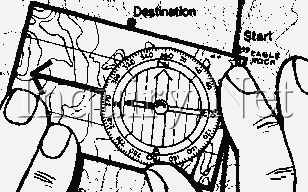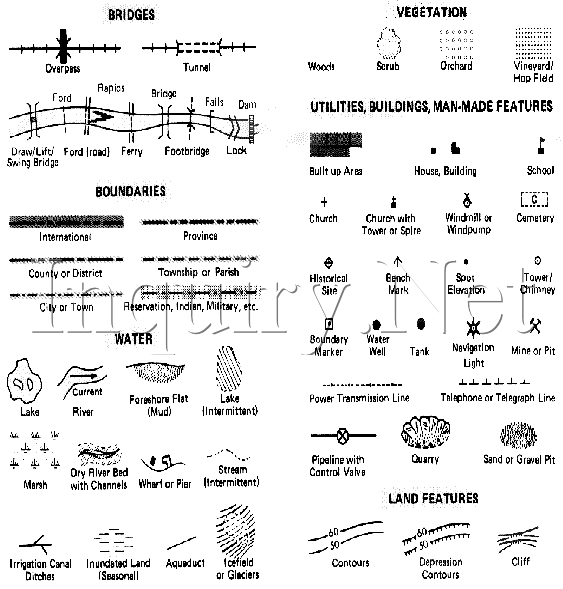
When you know where north is from looking at the compass needle, you should have no difficulty in finding the principal points of the compass. When you face north, south is then directly behind you, west on your left, east on your right.
In the old days when a person went to sea to become a sailor, they had to learn the 32 points of the compass. This was known as the compass rose and got quite complicated. The diagram above only shows 8 of these points.
Fortunately for us, somebody finally suggested the use of the 360 degree circle instead of names.
Setting a Map
A map is set or "oriented" when it is made to correspond with the ground it represents. In North American, north is always the top part of the map.
There are three simple steps in using the compass and map together:

Step 1: Place the compass on the map and join together the "start" and
"destination" with the long edge of the compass base-plate. Check that the
direction of travel ("D.O.T.") arrow points the way you are to go.

Step 2: Turn the compass dial until the orienting lines on the
compass housing are parallel to the
meridian lines on the map. Check that north on the dial is towards map north.
You now have your bearing. It is the number opposite the end of the direction of
travel arrow.

Step 3: Take the compass off the map. Without touching the
housing, hold it flat and turn your
whole body
around until the north (usually red) end of the needle points to "north" on your dial. Your
bearing is now the way that the direction of travel arrow points. Look for
the furthest two objects you can see along your bearing (like the rocks and tree in the
illustration above), and keep them lined up as you walk toward
them. Pick a third distant object as you get closer to the first
two.
Check Your Position Regularly
Keep your map and compass handy and refer to them every half hour or so to locate your position (more often in low visibility). Keep track of your starting time, rest breaks, lunch stops, and general hiking pace. This will also give you an idea of how far you have traveled and whether you've planned your time accurately.
Map Scales
The scale of a map compares its size with the size of the area it represents. One of the first things a Pathfinder must note, in order to understand a topographical map, is the scale to which the map is drawn. All maps indicate their scales in the margin or in a "legend." A scale of 1:250,000 (be it in inches, feet or meters) means 1 unit on the map is the equivalent of 250,000 units in the real world. So one inch measured on the map would be the equivalent of 250,000 inches in the real world. Most Canadian Topographical maps are either 1:250,000 or 1:50,000.
Map References

If you flew over an area, you would see roads, buildings, mountains, forests, rivers, and lakes. On a map, many of these features from "real life" are represented by symbols such as those shown above.